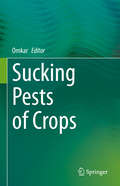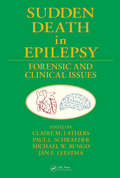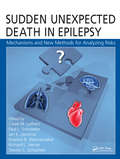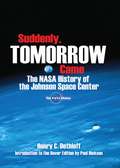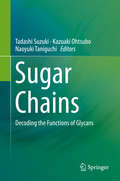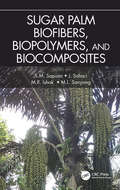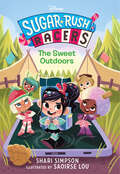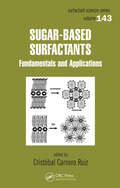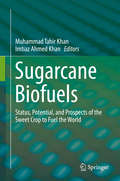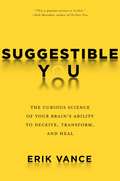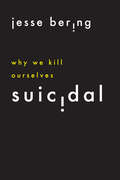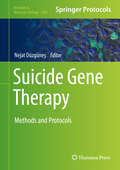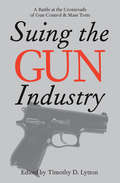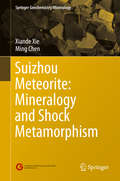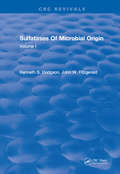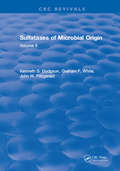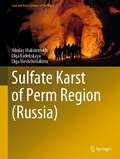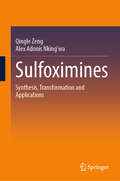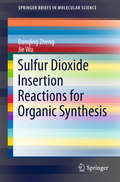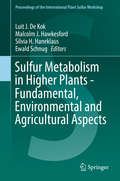- Table View
- List View
Sucking Pests of Crops
by OmkarSucking pests are most notorious group of pests for agricultural crops. Unlike most pests with chewing mouth parts, sucking pests cause more severe damage to the crops and are complex to get identified until advanced stages of infection. Not only is this late detection detrimental to their effective control, sucking pests also often cause fungal growth and virus transmission. The book emphasizes on sucking pests of most major crops of India. It aims to reflect Indian scenario before the international readership. This book complies comprehensive information on sucking pests of crops and brings the attention of the readers to this multiple damage causing insect complex. The chapters are contributed by highly experienced Indigenous experts from Universities & ICAR institutes, and book collates useful content for students and young researchers in plant pathology, entomology and agriculture.
Sudden Death in Epilepsy: Forensic and Clinical Issues
by Jan E. Leestma Claire M. Lathers Paul L. Schraeder Michael W. BungoThough it is one of the most common causes of death in epilepsy patients, SUDEP is still infrequently and even reluctantly named on autopsy reports. This under-reporting equates to a lack of attention and earnest investigation into the cause, predisposition, and prevention of SUDEP. There is as yet little effort to establish an actionable strategy
Sudden Unexpected Death in Epilepsy: Mechanisms and New Methods for Analyzing Risks
by Steven C. Schachter Jan E. Leestma Claire M. Lathers Paul L. Schraeder Braxton B. Wannamaker Richard L. VerrierSudden Unexpected Death in Epilepsy: Mechanisms and New Methods for Analyzing Risks builds on earlier works focusing on the clinical problem of sudden unexpected death in epilepsy (SUDEP). This book presents a methodology for identifying and classifying clusters of risks that lead to SUDEP. Developed over the last two years, the SUDEP Classificatio
Suddenly, Tomorrow Came: The NASA History of the Johnson Space Center (Dover Books on Astronomy)
by Paul Dickson Henry C. DethloffAs the astronauts' home base and the site of Mission Control, the Johnson Space Center has witnessed some of the most triumphant moments in American history. Spanning initiatives from the 1960s to 1993, this illustrated volume traces the center's history, starting with its origins at the beginning of the space race in the late 1950s. Thrilling, authoritative accounts explain the development and achievements of the early space voyages; the lunar landing; the Mercury, Gemini, and Apollo programs; and the space shuttles and international space station. As astronaut Donald K. Slayton notes in his Foreword, this chronicle emphasizes the cooperation of "humans on space and on the ground. It realistically balances the role of the highly visible astronaut with the mammoth supporting team." An official NASA publication, Suddenly, Tomorrow Came is profusely illustrated with forty-four figures and tables, plus sixty-three photographs. Historian Paul Dickson brings the narrative up to date with an informative new Introduction.
Sugar Chains
by Tadashi Suzuki Kazuaki Ohtsubo Naoyuki TaniguchiThis book presents the latest breakthrough results in glycobiology regarding the roles of glycans in relation to quality control and transport of protein, the immune system, viral infection, stem cells, the neural system, and various diseases such as cancer, diabetes, chronic obstructive pulmonary disease, muscular dystrophy, and schizophrenia. Although glycoscience has long been regarded as a very specialized field with no simple analytical method, the recent explosive progress in research continues to provide limitless evidence that glycan chains are the key component in various biological phenomena. Cell surface glycans, for example, change with developmental stages or environmental conditions and thus represent a "face" of the cell that is utilized for identification of iPS and ES cells and as biomarkers in diagnosis or detection of cancer. This book comprises 17 chapters, each of which poses outstanding "glyco-related" questions enabling non-specialists to have a clearer idea about what the future direction for further investigation of glycans in their own research fields will be. Also including basic information to understand the nature of glycans, this title serves as an excellent "textbook" for researchers in diverse research fields who are not familiar with, but nevertheless interested in, glycan chains or sugar chains.
Sugar Palm Biofibers, Biopolymers, and Biocomposites
by S. M. Sapuan J. Sahari M. R. Ishak M. L. SanyangNatural fibre composites are increasingly being viewed as viable and environmentally responsible alternatives to synthetic fibre composites and plastics. Sugar Palm Biofibers, Biopolymers, and Biocomposites considers the use of sugar palm fibres for materials development and application. It offers original research on the properties and behavior of sugar palm’s fibres, polymers, and biocomposites, covering mechanical, physical, thermal, chemical, environmental, morphological properties, as well as optimal design. It discusses sugar palm fibre thermosetting composites, sugar palm fibre thermoplastic composites, impregnation of sugar palm fibre, various lengths of sugar palm fibres, forms and arrangements such as particulate, continuous roving, and woven fabrics. The book also discusses innovations in commercialized products derived from sugar palm.
Sugar Rush Racers: The Sweet Outdoors (Sugar Rush Racers)
by Shari SimpsonThe Sugar Rush Racers from WRECK-IT RALPH are catapulted out of their arcade game and into the world of a young girl named Molly, in this chapter book series.Molly can't wait for her camping trip with troop! Until she learns there are NO DEVICES ALLOWED, but the Sugar Rush Racers convince Molly to sneak her tablet into the camping trip. Everyone knows the best part of the trip is the scavenger hunt but when the team get lost and Molly pulls out her tablet to try to help, everyone turns on her for breaking the rules. How will the Sugar Rush Racers help her get out of this one!Add the other candy-coated title to your collection: Victory is Sweet
Sugar Rush Racers: Victory is Sweet (Sugar Rush Racers)
by Shari SimpsonVanellope Von Schweetz and the other racers from Sugar Rush are catapulted out of their arcade game and into the world of a young girl named Molly, in this chapter book series.Molly McGinty is surprised when she comes home from the arcade and Vanellope and her friends are in her tablet! But when she fights with her best friend and needs help with her go-kart she has no one to turn to but the Sugar Rush Racers. Everyone has to work together as a team to accomplish the goals.Add the other candy-coated title to your collection: The Sweet Outdoors
Sugar and Sugar Derivatives: Changing Consumer Preferences
by Priyanka Singh Narendra MohanSugarcane enjoys a prominent position among agro-industrial crops and is commercially grown in 115 tropical and subtropical countries around the world. However, fluctuations in sugar prices have forced the sugarcane industry worldwide to broaden its revenue base by moving from single-commodity manufacturing to a range of value-added products. Utilizing the by-products in an innovative manner to create value-added products is the new course of action for sugar-producing countries. For many years sugarcane was regarded as a single-product crop, i.e., only useful for producing sugar. Its actual potential is now increasingly being recognised by the industry and there is a growing trend toward the manufacturing of allied products from sugarcane. Therefore, the focus is now on the establishment of sugar-agro-industry complexes, processing not just sugar but a range of other products. This book provides a comprehensive overview of sugarcane not only as a source of sweetening agents but also for many other uses, including as a source of bio-energy. It also explores the trend of sugar consumption and suggests practices to curb the consumption of sugar products in order to tackle obesity and reduce public health costs. The book underscores the need to diversify sugarcane and highlights means of doing so, while also addressing various innovations and technologies being developed in connection with sugar, sugar derivatives, and sugar industry by-products for sustainable utilization in the sugar-agro industry. Accordingly, it offers a valuable resource for professionals and R&D units in the sugar industry, and for students of agronomy and related fields.
Sugar-Based Surfactants: Fundamentals and Applications
by Cristóbal Carnero RuizTouted as the new darling of the chemical industry, alkyl polyglycosides are gaining in popularity due to the fact that they are readily biodegradable, low-toxic, and made from renewable resources. Sugar-Based Surfactants compiles the most recent and relevant aspects of sugar-based surfactants, including self-association, phase behavior, and interf
Sugarcane Biofuels: Status, Potential, and Prospects of the Sweet Crop to Fuel the World
by Muhammad Tahir Khan Imtiaz Ahmed KhanSugarcane exhibits all the major characteristics of a promising bioenergy crop including high biomass yield, C4 photosynthetic system, perennial nature, and ratooning ability. Being the largest agricultural commodity of the world with respect to total production, sugarcane biomass is abundantly available. Brazil has already become a sugarcane biofuels centered economy while Thailand, Colombia, and South Africa are also significantly exploiting this energy source. Other major cane producers include India, China, Pakistan, Mexico, Australia, Indonesia, and the United States. It has been projected that sugarcane biofuels will be playing extremely important role in world’s energy matrix in recent future.This book analyzes the significance, applications, achievements, and future avenues of biofuels and bioenergy production from sugarcane, in top cane growing countries around the globe. Moreover, we also evaluate the barriers and areas of improvement for targeting efficient, sustainable, and cost-effective biofuels from sugarcane to meet the world’s energy needs and combat the climate change.
Sugars That Heal: The New Healing Science of Glyconutrients
by Emil I. Mondoa"Sugars that heal" it sounds like a contradiction in terms, but it's the key to one of the most important breakthroughs in recent medical science. We've all been bombarded with warnings about the evils of consuming too much sugar. But, in fact, for our bodies to function properly, we need small amounts of eight essential sugars, only two of which--glucose and galactose--are commonly found in our limited, overprocessed diets. When all eight sugars are available, the health benefits can be breathtaking: Individuals regain their ability to fight disease, reactivate their immune systems, and are able to ward off infection. Based on cutting-edge research in the rapidly evolving science of glyconutrients, Sugars That Heal is an exciting new approach to health and disease prevention.As medical doctor and scientific researcher Emil Mondoa explains, these eight essential sugars, known as saccharides, are the basis of multicellular intelligence--the ability of cells to communicate, cohere, and work together to keep us healthy and balanced. Even tiny amounts of these sugars--or lack of them--have profound effects. In test after test conducted at leading institutes around the world, saccharides have been shown to lower cholesterol, increase lean muscle mass, decrease body fat, accelerate wound healing, ease allergy symptoms, and allay autoimmune diseases such as arthritis, psoriasis, and diabetes. Bacterial infections, including the recurrent ear infections that plague toddlers, often respond remarkably to saccharides, as do many viruses--from the common cold to the flu, from herpes to HIV. The debilitating symptoms of chronic fatigue syndrome, fibromyalgia, and Gulf War syndrome frequently abate after adding saccharides. And, for cancer patients, saccharides mitigate the toxic effects of radiation and chemotherapy--while augmenting their cancer-killing effects, resulting in prolonged survival and improved quality of life. Sugars That Heal offers a revolutionary new health plan based on the science of glyconutrients--foods that contain saccharides. It gives authoritative guidance for getting all eight saccharides conveniently into your diet through supplements and readily available foods, as well as detailed information on correct dosages. Here, too, are chapters dealing with the special nutritional needs of people suffering from cancer, heart disease, asthma, and neurological disorders, and methods for using glyconutrients to treat depression, obesity, and ADHD.The more doctors learn about glyconutrients, the more excited they become about their long-term fundamental health benefits. Now, with this new book, the breakthroughs in the study of glyconutrients are available to everyone. Whether your goal is to prevent disease, live longer and better, or treat a serious illness that has eluded conventional medicine, Sugars That Heal is your essential guide to complete health.From the Hardcover edition.
Suggestible You: The Curious Science of Your Brain's Ability to Deceive, Transform, and Heal
by Erik VanceThis riveting narrative explores the world of placebos, hypnosis, false memories, and neurology to reveal the groundbreaking science of our suggestible minds. Could the secrets to personal health lie within our own brains? Journalist Erik Vance explores the surprising ways our expectations and beliefs influence our bodily responses to pain, disease, and everyday events. Drawing on centuries of research and interviews with leading experts in the field, Vance takes us on a fascinating adventure from Harvard's research labs to a witch doctor's office in Catemaco, Mexico, to an alternative medicine school near Beijing (often called "China's Hogwarts"). Vance's firsthand dispatches will change the way you think--and feel. Expectations, beliefs, and self-deception can actively change our bodies and minds. Vance builds a case for our "internal pharmacy"--the very real chemical reactions our brains produce when we think we are experiencing pain or healing, actual or perceived. Supporting this idea is centuries of placebo research in a range of forms, from sugar pills to shock waves; studies of alternative medicine techniques heralded and condemned in different parts of the world (think crystals and chakras); and most recently, major advances in brain mapping technology. Thanks to this technology, we're learning how we might leverage our suggestibility (or lack thereof) for personalized medicine, and Vance brings us to the front lines of such study.
Suicidal: Why We Kill Ourselves
by Jesse BeringThis personal inquiry into the psychology of suicide brings “compassion, confessional honesty, and academic perception” to a woefully misunderstood subject (Kirkus Reviews).Despite his success as a psychologist and writer, Jesse Bering spent most of his thirties believing he would probably kill himself. At times, the impulse to take his own life felt all but inescapable. When his suicidal thoughts began to fade, he felt relieved—but also curious. He wondered where they came from and if they would return; whether other animals experienced the same impulse, or if it was a uniquely human evolutionary development. In Suicidal, Bering answers all these questions and more.Drawing on personal stories, scientific studies, and remarkable cross-species comparisons, Bering explores the science and psychology of suicide. Revealing its cognitive secrets and the subtle tricks our minds can play on us, Bering helps readers analyze their own doomsday thoughts while gaining broad insight into the subject. Authoritative, accessible, personal, and profound, Suicidal will change the way you think about this most vexing of human problems.
Suicide Gene Therapy: Methods and Protocols (Methods in Molecular Biology #1895)
by Nejat Düzgüneş<p>This detailed volume explores the methods used for most of the recent approaches to suicide gene therapy of cancer, which exploits promoters that are specific to cancer cells, thereby ensuring (or greatly increasing the likelihood) that the therapeutic gene is expressed only in cancer cells. The book also contains chapters describing methods to improve the safety of cell therapy and techniques utilizing bone marrow mesenchymal cells. Written for the highly successful Methods in Molecular Biology series, chapters include introductions to their respective topics, lists of the necessary materials and reagents, step-by-step, readily reproducible laboratory protocols, and tips on troubleshooting and avoiding known pitfalls. <p>Authoritative and practical, Suicide Gene Therapy: Methods and Protocols serves as an ideal guide for researchers expanding upon our knowledge and application of this vital form of cancer therapy.</p>
Suicide Postvention in the Department of Defense: Evidence, Policies and Procedures, and Perspectives of Loss Survivors
by Rajeev Ramchand Dionne Barnes-Proby Gail Fisher Lynsay Ayer Karen Chan Osilla Samuel WertheimerA review of the scientific evidence on suicide postvention (organizational responses to prevent additional suicides and help loss survivors cope), guidance for other types of organizations, and the perspectives of the family and friends of service members who have died by suicide provide insights that may help the U. S. Department of Defense formulate its own policies and programs in a practical and efficient way.
Suing the Gun Industry: A Battle at the Crossroads of Gun Control and Mass Torts
by Timothy D. Lytton"Mass tort litigation against the gun industry, with its practical weaknesses, successes, and goals, provides the framework for this collection of thoughtful essays by leading social scientists, lawyers, and academics. . . . These informed analyses reveal the complexities that make the debate so difficult to resolve. . . . Suing the Gun Industry masterfully reveals the many details contributing to the intractability of the gun debate. " -New York Law Journal "Second Amendment advocate or gun-control fanatic, all Americans who care about freedom need to readSuing the Gun Industry. " -Bob Barr, Member of Congress, 1995-2003, and Twenty-First Century Liberties Chair for Freedom and Privacy, American Conservative Union "Thesource for anyone interested in a balanced analysis of the lawsuits against the gun industry. " -David Hemenway, Professor of Health Policy & Director, Harvard Injury Control Research Center Harvard School of Public Health Health Policy and Management Department, author ofPrivate Guns, Public Health "Highly readable, comprehensive, well-balanced. It contains everything you need to know, and on all sides, about the wave of lawsuits against U. S. gun manufacturers. " -James B. Jacobs, Warren E. Burger Professor of Law and author ofCan Gun Control Work? "InSuing the Gun Industry, Timothy Lytton has assembled some of the leading scholars and advocates, both pro and con, to analyze this fascinating effort to circumvent the well-known political obstacles to more effective gun control. This fine book offers a briefing on both the substance and the legal process of this wave of lawsuits, together with a better understanding of the future prospects for this type of litigation vis-à-vis other industries. " -Philip J. Cook, Duke University "An interesting collection, generally representing the center of the gun-control debate, with considerable variation in focus, objectivity, and political realism. " -Paul Blackman, retired pro-gun criminologist and advocate Gun litigation deserves a closer look amid the lessons learned from decades of legal action against the makers of asbestos, Agent Orange, silicone breast implants, and tobacco products, among others. Suing the Gun Industrycollects the diverse and often conflicting opinions of an outstanding cast of specialists in law, public health, public policy, and criminology and distills them into a complete picture of the intricacies of gun litigation and its repercussions for gun control. Using multiple perspectives,Suing the Gun Industryscrutinizes legal action against the gun industry. Such a broad approach highlights the role of this litigation within two larger controversies: one over government efforts to reduce gun violence, and the other over the use of mass torts to regulate unpopular industries. Readers will findSuing the Gun Industrya timely and accessible picture of these complex and controversial issues. Contributors: Tom Baker Donald Braman Brannon P. Denning Tom Diaz Howard M. Erichson Thomas O. Farrish Shannon Frattaroli John Gastil Dan M. Kahan Don B. Kates Timothy D. Lytton Julie Samia Mair Richard A. Nagareda Peter H. Schuck Stephen D. Sugarman Stephen Teret Wendy Wagner
Suizhou Meteorite: Mineralogy and Shock Metamorphism
by Ming Chen Xiande XieThis book introduces the unusual shock-related mineralogical features of the shocked Suizhou L6 (S5) meteorite. The olivine and pyroxene in Suizhou display a mosaic shock feature, while most of plagioclase grains have transformed to glassy maskelynite. A few of the shock-induced melt veins in the meteorite are the simplest, straightest and thinnest ones among all shock-vein-bearing meteorites, and contain the most abundant high-pressure mineral species. Among the 11 identified species, tuite, xieite, and the post-spinel CF-phase of chromite are new minerals. The meteorite experienced a peak shock pressure up to 24 GPa and temperatures of up to 1000° C. Locally developed shock veins were formed at the same pressure, but at an elevated temperature of about 2000° C that was produced by localized shear-friction stress. The rapid cooling of the extremely thin shock veins is the main reason why 11 shock-induced high-pressure mineral phases could be preserved in them so well. This book offers a helpful guide for meteoritics researchers and mineralogists and invaluable resource for specialists working in high-pressure and high-temperature mineralophysics.
Sulfatases Of Microbial Origin: Volume 1
by Kenneth S. DodgsonIn the succeeding pages the authors have collated scattered information about individual sulfatases and have endeavoured to indicate their physiological roles within the microorganism, the ways in which their synthesis is subject to genetic and physiological control, and their participation in natural processes such as the recycling sulfur. The authors have also attempted, for the first time, to discuss at length the mechanisms of action of some of the enzymes in relation to current knowledge about the nonenzymic hydrolysis of various types of sulfate ester. Although primarily directed towards those people interested in biochemistry and enzymology of microorganisms, it is the authors belief that there will be much in the book that will be of interest to worker in the mammalian field.
Sulfatases Of Microbial Origin: Volume 2
by Kenneth S. DodgsonIn the succeeding pages the authors have collated scattered information about individual sulfatases and have endeavoured to indicate their physiological roles within the microorganism, the ways in which their synthesis is subject to genetic and physiological control, and their participation in natural processes such as the recycling sulfur. The authors have also attempted, for the first time, to discuss at length the mechanisms of action of some of the enzymes in relation to current knowledge about the nonenzymic hydrolysis of various types of sulfate ester. Although primarily directed towards those people interested in biochemistry and enzymology of microorganisms, it is the authors belief that there will be much in the book that will be of interest to worker in the mammalian field.
Sulfate Karst of Perm Region (Cave and Karst Systems of the World)
by Nikolay Maksimovich Olga Meshcheriakova Olga KadebskayaThe book provides a characteristic of sulfate karst, the features of its distribution and development in the Perm region, based on their own research and generalization of data accumulated in recent years. An updated zoning of the territory is given, partly based on the use of GIS technologies. This book also offers a detailed description of areas with characteristics of geological and hydrogeological conditions for the development of karst and karst phenomena. Besides, it also provides a detailed description of a number of caves, information about specially protected natural areas associated with sulfate karst and new unique objects that need protection. The book describes the influence of karst on economic activity and the ecological situation.The publication is intended for geologists, geographers, ecologists, karst scientists, speleologists, local historians, teachers and students of specialties related to earth sciences, as well as a wide range of karst and cave enthusiasts.
Sulfate-Reducing Bacteria and Archaea
by Larry L. Barton Guy D. FauqueThe abundance of sulfate-reducing bacteria and archaea (SRBA) is impressive and new isolates are being reported continuously. A few decades ago, only two genera of sulfate-reducing bacteria (SRB) had been identified. As of 2018, 92 genera containing more than 420 species of SRB have been isolated and characterized and there are several species of archaea. This book addresses the development of the research with SRBA and includes historical background of this field. Biochemical characterization of the enzymes, cytochromes and electron carriers involved with dissimilatory sulfate reduction are reviewed and the presence of relevant genes in cultured and uncultured SRBA are assessed using genome analysis. The contributions of transmembrane electron transport complexes as related to cell energetics are discussed. This book highlights the unique cellular and molecular features of the SRBA and discusses the biochemical interactions behind their metabolic capabilities which enable SRBA to grow in extreme environments. Examples are provided to detoxify and alleviate pollution situations, to evaluate mechanisms proposed for corrosion of ferrous metals and to examine the effects of SRB on human and animal hosts.
Sulfoximines: Synthesis, Transformation and Applications
by Qingle Zeng Alex Adonis Nking’waThis book provides an easy to understand explanation of sulfoximines, explaining how they are made, structural complexities, and how they are used, especially in medicinal chemistry. You will learn new ways to synthesize these compounds and discover how they can help in drugs discovery and development. Key topics include how to synthesize sulfoximines, cyclic sulfoximines, their special properties, and their applications. These compounds are important because they can lead to new and more effective drugs. Understanding sulfoximines can help researchers develop better treatments for various diseases. This work addresses the challenge of finding better methods for drug discovery. By offering clear explanations and practical examples, it helps bridge the gap between theory and practice. The focus on sulfoximines’ unique qualities and their potential in medicine makes this book a valuable resource for anyone in the pharmaceutical field. Special features include clear visuals, detailed schemes, and an easy-to-follow approach that makes complex ideas simple. This book is suitable for researchers, chemists, and students. It guides readers through the world of sulfoximines, helping them understand their importance in modern drugs. Whether you are an experienced researcher or a student, this guide will help you explore the latest advancements in sulfoximine chemistry.
Sulfur Dioxide Insertion Reactions for Organic Synthesis
by Jie Wu Danqing ZhengThis brief summarizes the most commonly used sulfur dioxide surrogates and also shows the diverse reactivities to highlight the advances made in the development of synthetic methods through the insertion of sulfur dioxide. Depending on the nature of the transformation, these reactions are classified into four types: (i) pericyclic reactions; (ii) nucleophilic addition with organometallic reagents; (iii) transition metal catalysis; and (iv) free radical reactions. Highlighting recent advances in the insertion of sulfur dioxide, providing detailed descriptions of the experimental procedures for these valuable reactions, and discussing the remaining challenges in this field, the brief offers an appealing and highly useful guide for a wide readership in organic chemistry and medicinal chemistry from both academia and industry.
Sulfur Metabolism in Higher Plants - Fundamental, Environmental and Agricultural Aspects
by Malcolm J. Hawkesford Ewald Schnug Luit J. De Kok Silvia H. HaneklausThis proceedings volume contains a selection of invited and contributed papers of the 10th International Workshop on Sulfur Metabolism in Plants, which was held in Goslar, Germany September 1-4, 2015. The focus of this workshop was on the fundamental, environmental and agricultural aspects of sulfur in plants, and presents an overview of the progress in the research developments in this field in the 28 years since the first of these workshops. The volume covers various aspects of the regulation of the uptake and assimilation of sulfate in plants from a molecular to a whole plant level with an emphasis on the significance of sulfur metabolism in plant responses to stress and in food security.
